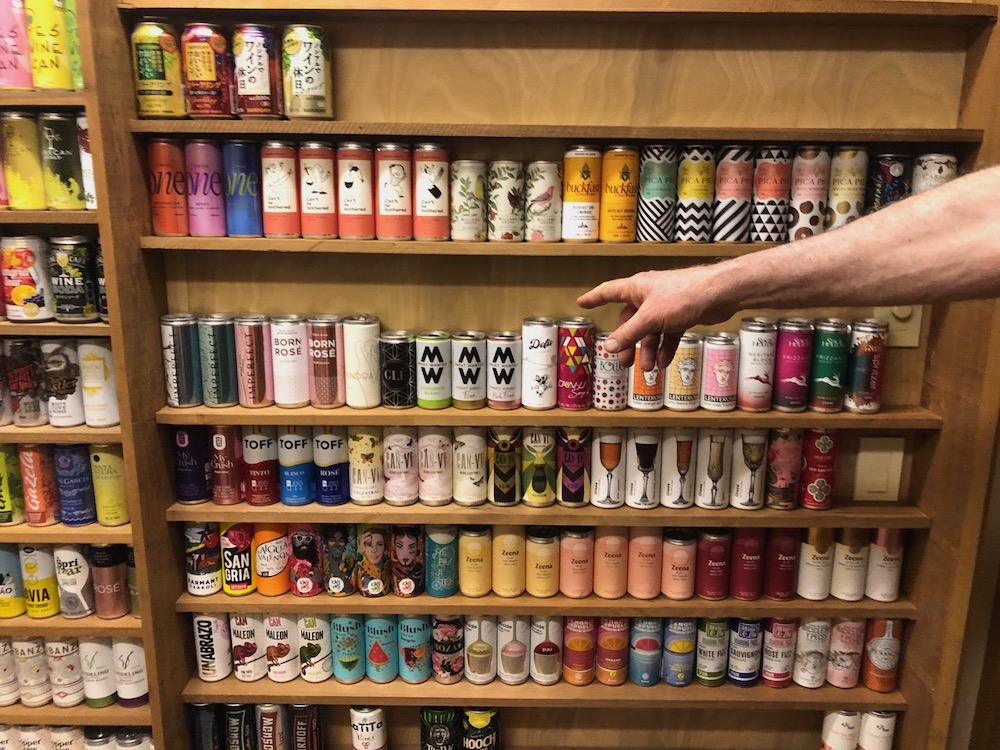
August 17, 2024 – Did you know that people have been putting wine in cans since the 1930s? Allan Green, Guinness World Record Holder for the largest canned wine collection in the world, will happily walk you through his incredible journey of more than 3,500 unique cans, assuming you are willing to brave the circuitous Philo-Greenwood Ridge Road to reach its blissfully remote location. The collection has been growing by leaps and bounds since Green started the Canned Wine Competition in Boonville 5 years ago.
We got to see this fascinating collection—housed in the spectacular Frank Lloyd Wright-inspired home which Allan’s father Aaron, designed and built for him—during the 2024 Canned Wine Competition in early August.
It’s a rare honor to judge the only canned wine competition in the world, which pulls in hundreds of entries each year. Green typically flies in a judge from Europe to join the domestic panelists. This year, it was Maria Scharffenberg, originally from Sweden, but currently living in Toronto, Canada, from where she ministers to the Church of Sweden’s congregants, scattered about North America. She is also a somm who teaches at a wine school in Berlin.
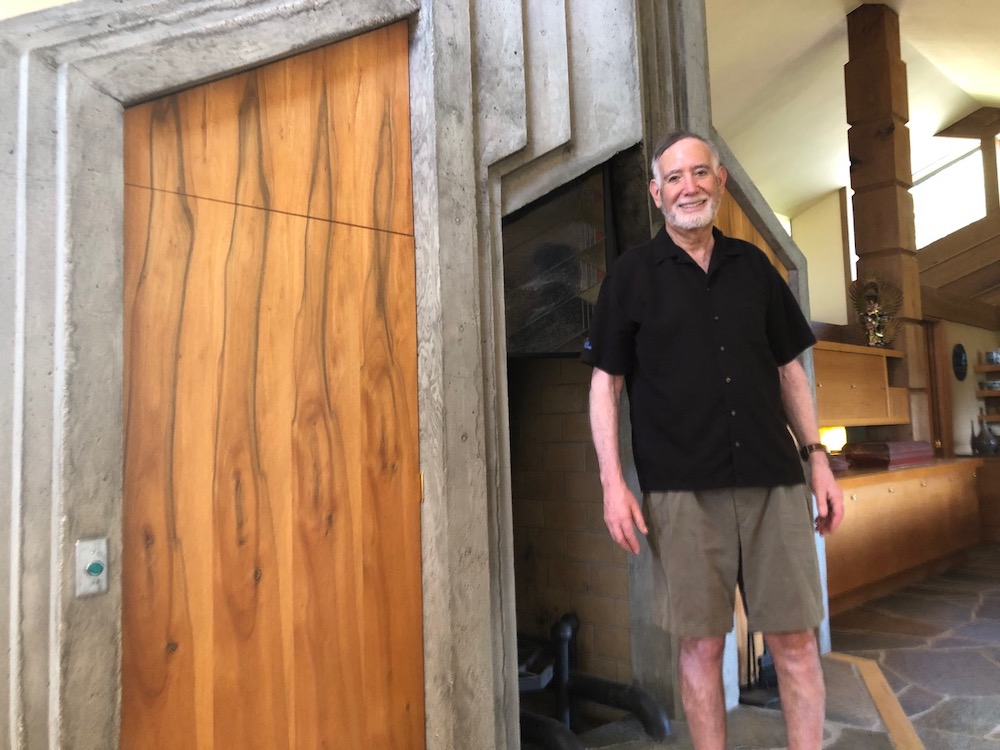
Arriving at Green’s one-of-a-kind museum home, there is no doubting its unmistakable Wright genetics. The massive garage glowers like a wooden fortress under an extended low-browed roofline. A simple Zenlike chime-lined entrance ushers you into the Chinese slate-floored entryway and that might be the last time you look down. Skylights and windows bring the outside in, and offer intimate wooded views, or soaring vistas into canyons that drop to the sea.
In fact, the house is reminiscent of the Mrs. Clinton Walker House that Wright penned for a wealthy patron in Carmel: built like a ship with its bow literally jutting into the ocean, it was damaged in the winter storms of 2023 and sold for $22M later that year.
Inside of Green’s Philo edifice, the walls are hung with treasures from Asia and Africa. Numerous paintings by Green’s gifted great aunt Rose Pauson depict life on Jackson Street in San Francisco, while gleaming cherrywood tables and built-in shelves display striking weavings by his grandmother Jeannette Haber Pauson, along with pottery by his mother Jean Haber. A bronze bust cast from a portrait taken on her wedding day, rests on a counter surrounded by artifacts from all over the world, most collected by her husband, a WWII Air Force bombardier. The daughter of Japanese art importer in San Francisco, Jean wears a strand of pearls, her countenance projecting quiet resolve.
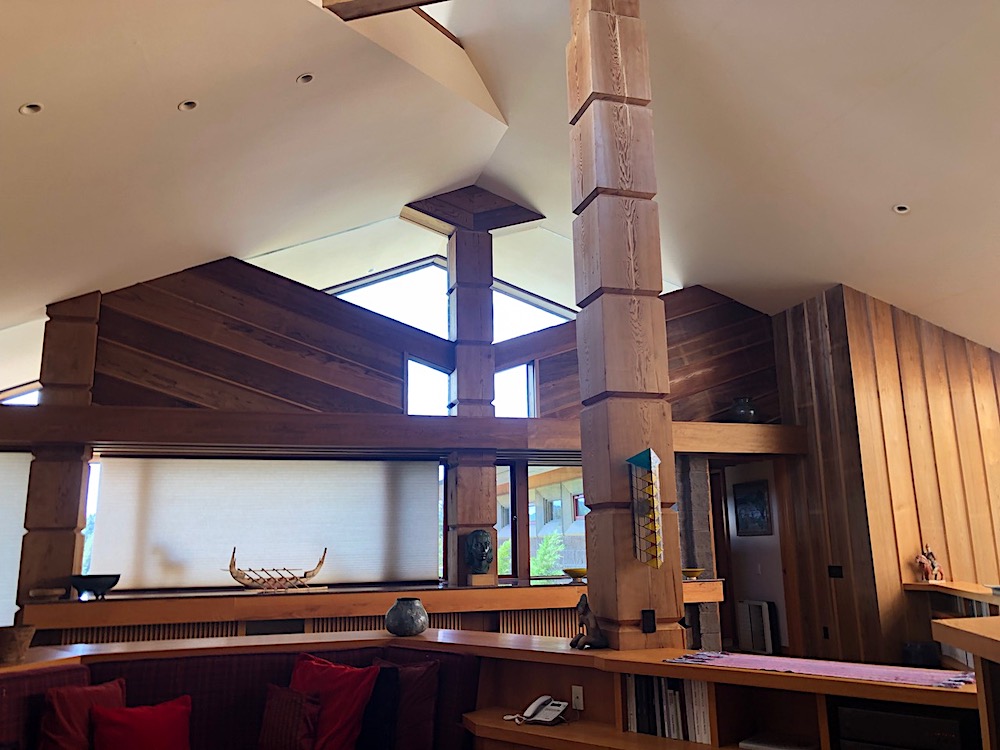
It is utterly remarkable to think that Green’s father survived three years of war in the Pacific Theater and returned home to build a career with arguably the most famous architect in America. Wright had invited Green, fresh out of school at Cooper Union in New York to join Taliesin West as an apprentice prior to Green joining the Air Force. They maintained a lifelong friendship and worked on over thirty California projects together, including the Marin Civic Center, and the medical center at 450 Church Street in Santa Cruz.
Green and his first wife, Jean Haber Green, raised two talented sons in the Los Altos Hills: Allan and Frank, a documentary filmmaker. Allan recalls growing up in Los Altos was nothing short of idyllic, with a vast garden filled with all earthly delights, plus trips to visit relatives in San Francisco. A painting by his great aunt Rose in the home’s entry depicts his mom, great aunt and grandmother, complete with family dog, buying a bouquet in the Union Square flower market.
On the other side of this wall is the sleek kitchen that flows into the dining room, the backdrop of which is an enormous concrete fireplace, made of a single casting. An adjacent door opens to a dumbwaiter, repurposed from a hospital in San Francisco, that transports wood up from the basement. The custom table matches the Frank Lloyd Wright designed chairs that were made in Italy, and their shape is echoed in the built-ins of the sunken living room.
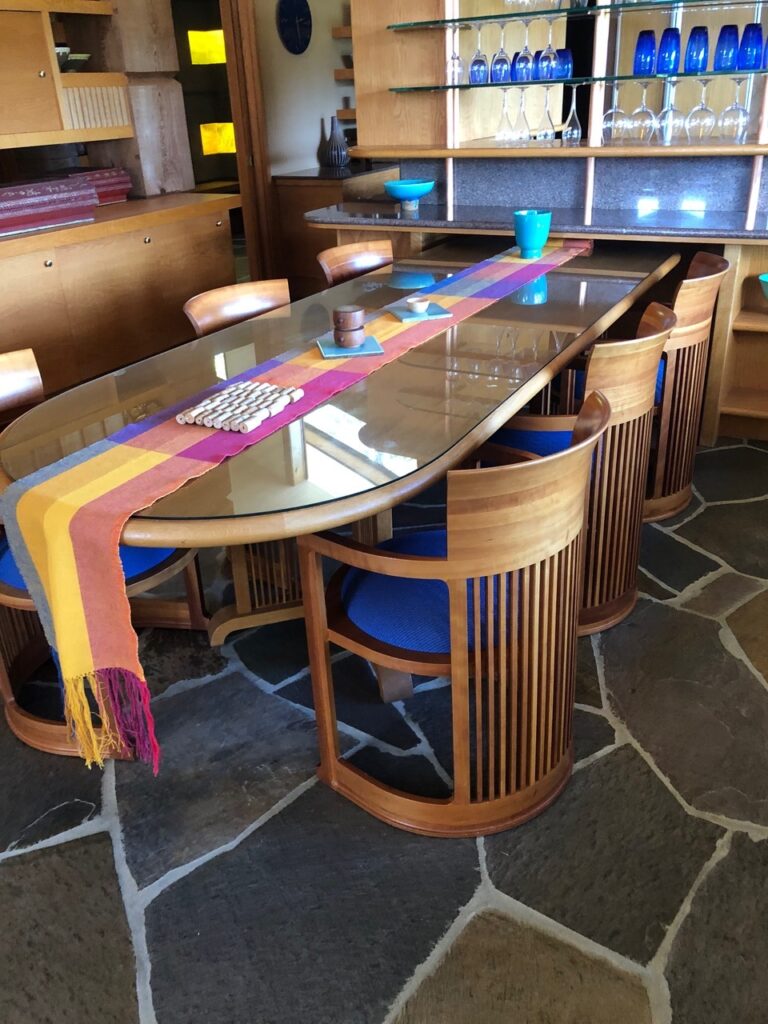
When he’s not collecting cans or organizing competitions, Green—a Men’s Senior Baseball League Hall of Famer—stills plays baseball and manages the Dragons team in the Redwood Empire League, and has 6 diamond-studded championship rings to show for it. He is probably most famous for founding the architecturally stunning Greenwood Ridge Winery in Anderson Valley, which was the first to install a Tesla charging station. He sold it to the Wilson Family in 2016.
Interestingly, the Greenwood Ridge dragon symbology, which Green had silkscreened on his elegant bottlings of Riesling and Merlot, and for which the baseball team is named, has its origins with his father, whose architectural office in San Francisco had a stunning dragon sculpture. Frank Lloyd Wright’s West Coast office shared the space for over 20 years, and in 1959, Aaron Green gave the sculpture to the Frank Lloyd Wright Foundation. At one point, Wright declared that Aaron was like a son to him. It is currently displayed at Taliesin West in Scottsdale. Although the sculpture was intended to be a fountain, Mrs. Wright made it breathe fire by installing a propane tank inside. Clearly, she had a sense of humor.
Seeing the collection of cans is a journey through many phases of the wine industry, and it’s fascinating to see the different sizes and types, along with the various themes that marked each decade. One thing remains constant: the designs are creative, eclectic and mostly asking to be noticed.
The Winning Wines of 2024
As for the winners of the competition, and the wines that stood out for me, here are the results:
Best of Show White Wine: Stag’s Hollow Winery 2023 Tragically Vidal
Best of Show Rosé Wine: Stag’s Hollow Winery 2023 Syrah Rosé
Best of Show Red Wine: Stoller Swing Pinot Noir
Best of Show Sparkling White Wine: The OBC Wine Project 2023 Colorado Fizz
Best of Show Sparkling Rosé Wine: Underwood Rosé Bubbles
Best of Show Sparkling Red Wine: Suntory Oishiiwine Sparkling Red Wine
Best of Show Spritzer: Blue Lobster Urban Winery Offshore Lemon Wine Spritzer
Because of the way the competition is done, over a two-day period with different judges, I did not taste all of these, but can speak to the Sparkling ones, as my panel had the pleasure of tasting them all. We also happened to choose the Best of Show Red, which was the Stoller Swing Pinot Noir from the Willamette Valley. This was effusively Pinot Noir in every way, and having it in a can means you can enjoy its freshness, most likely in one sitting.
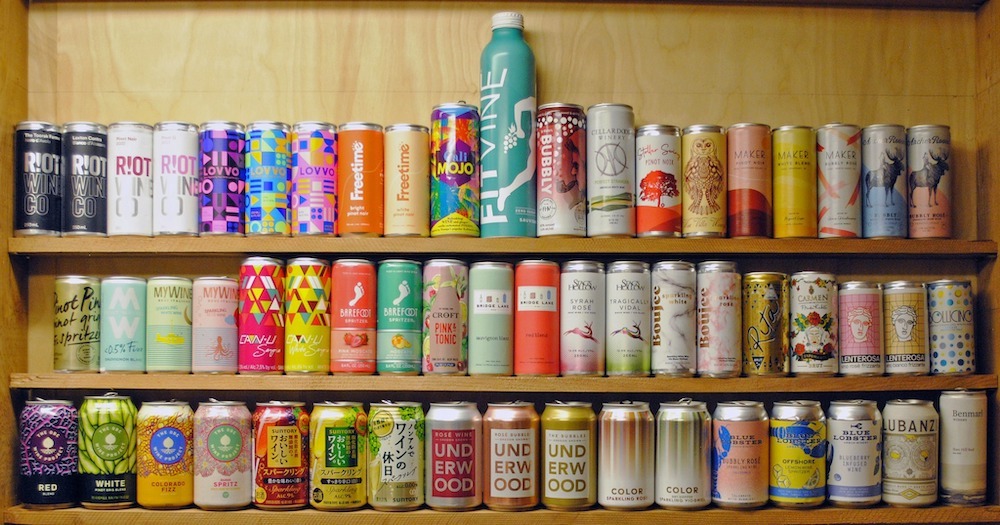
The Best of Class Sparkling White Wine, the OBC (Odell Brewing Company) Wine Project 2023 Colorado Fizz, is something I will happily recommend to anyone. Made of 75% Vignoles and 25% Aromella, the peach bellini nose was super fun and inviting, and the fruity flavors were all there like a full orchestra to back it up. This wine is a bachelorette party in a can. It had a tough fight against the other double gold medalists, including a wine called Rita Sparkling, a sparkling white Lambrusco, and how could I resist a wine called Frida Kahlo Brut, with its flirty floral nose and pretty bubbles?
The Best of Show Sparkling Rosé is one you can easily find anywhere: Underwood has been making canned wine from Oregon for years, and this is a good example of a well-made wine that’s meant to be enjoyed right from the cool pink colored can. From the first whiff and subsequent sip, it’s friendly, approachable, quaffable and tastes like Pinot Noir. A recent study indicates that at least half the people who consume canned wines do so out of a glass. Presumably, they’re not whitewater rafting at the time.
But back to the OBC Colorado Fizz, which could easily be the gateway for first time drinkers into the greater wine world. The fact that it is made of two hybrid grapes is even more exciting and provides insight into why grape breeders at Cornell (among other universities in the Midwest and East), go to such great lengths to create cold-climate-hearty grapes that actually taste good.
So, what’s a hybrid?
A hybrid is a cross between native North American grape varieties, called labrusca, and classic European wine grape varieties, called vinifera. Vignoles is primarily based on Viognier, while Aromella is a cross between two hybrids, one of which is Traminette, whose dominant parent is the highly aromatic and spicy Gewurztraminer, a vinifera grape. In the Finger Lakes, where Aromella was first planted commercially in 2005, it is often referred to as Moscato-like, again a very aromatic grape, known for its unabashed fruitiness.
So, that’s how they can grow really great tasting grapes in Colorado that taste like a party in a can. It took a lot of bio-engineering, as did Allan Green’s spectacular house, which seems to crouch like a panther in the forest, intent on elusive game.And now thanks to Allan Green, you not only know about Aromella, but you also know a little bit more about Frank Lloyd Wright, and the architect he once referred to as his son. Together, they have left a lasting legacy of architecture that has come to define the American West.
About the author
Laura Ness is a longtime wine journalist, columnist and judge who contributes regularly to Edible Monterey Bay, Spirited, WineOh.Tv, Los Gatos Magazine and Wine Industry Network, and a variety of consumer publications. Her passion is telling stories about the intriguing characters who inhabit the fascinating world of wine and food.
- Laura Nesshttps://www.ediblemontereybay.com/author/lness/
- Laura Nesshttps://www.ediblemontereybay.com/author/lness/
- Laura Nesshttps://www.ediblemontereybay.com/author/lness/
- Laura Nesshttps://www.ediblemontereybay.com/author/lness/


